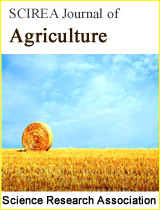Seed shape quantification in Capparis spinosa L.: Effect of subspecies and geographic regions
DOI: 493 Downloads 16644 Views
Author(s)
Abstract
Seed shape quantification is an important tool in taxonomy and biodiversity studies. Seed images are compared with geometric figures and percent of identity is obtained (J index). Seed images of Arabidopsis and model legumes (Lotus and Medicago) adjust well to a cardioid allowing studies of shape variation in development and germination and mutant phenotyping. In this work we compare seed shape in two subspecies of Capparis spinosa: rupestris and spinosa. Capparis spinosa seed images adjust well to a cardioid. J index values are higher in subsp. spinosa. Division of the image in quadrants allows the identification of morphological types with different proportions in the subspecies. Seeds of subsp. rupestris have more morphological diversity. Among the four quadrants differences between subspecies are found in Q1 and Q2. The comparison between geographic locations for subsp. rupestris reveals reduced area and J index partial values in Q3 and Q4 in the seeds obtained in the desert.
Keywords
Capparis spinosa, biodiversity; cardioid; shape; morphometry; seeds
Cite this paper
José Javier Martín, Ezzeddine Saadaoui, Emilio Cervantes,
Seed shape quantification in Capparis spinosa L.: Effect of subspecies and geographic regions
, SCIREA Journal of Agriculture.
Volume 1, Issue 1, October 2016 | PP. 79-90.
References
| [ 1 ] | Corner, E.J.H. The Seeds of Dicotyledons. Cambridge University Press. 1976. |
| [ 2 ] | Cervantes, E.; Martín, J.J.; Saadaoui, E. Updated Methods for Seed Shape Analysis. Scientifica (Cairo) 2016, 5691825. Published online 2016 Apr 13. doi:10.1155/2016/5691825. |
| [ 3 ] | Herridge, R.P.; Day, R. C.; Baldwin, S. and Macknight, R.S. Rapid analysis of seed size in Arabidopsis for mutant and QTL discovery. Plant Methods 2011, 7:3. |
| [ 4 ] | Tanabata, T.; Shibaya, T.; Hori, K.; Ebana, K.; and Yano, M. SmartGrain: High-Throughput Phenotyping Software for Measuring Seed Shape through Image Analysis. Plant Physiol 2012, 160(4):1871-80. |
| [ 5 ] | Ferreira, T.; Wayne, R. The Image J User Guide. First edition v 1.43. 2010. http://imagej.nih.gov/ij/docs/guide/index.html# |
| [ 6 ] | Keefe, R.F. and Davis, A.S. Modeling individual conifer seed shape as a sum of fused partial ellipsoids. Canadian J Forest Res 2010, 40, 2175–2186. |
| [ 7 ] | Cervantes, E.; Martín, J.J.; Ardanuy, R.; de Diego, J.G.; Tocino, A. Modeling the Arabidopsis seed shape by a cardioid: efficacy of the adjustment with a scale change with factor equal to the Golden Ratio and analysis of seed shape in ethylene mutants. J Plant Physiol 2010, 167, 408-410. doi:10.1016/j.jplph.2009.09.013. Available online: http://www.sciencedirect.com/science/article/pii/S0176161709003939 (accessed on 20June2016). |
| [ 8 ] | Cervantes, E.; Martín, J.J.; de Diego, J.G.;Chan, P.K.; Gresshoff, P.; Tocino, A. Seed shape in model legumes: approximation by a cardioid reveals differences between Lotus and Medicago. J Plant Physiol 2012, 169, 1359-1365. doi: 10.1016/j.jplph.2012.05.019. |
| [ 9 ] | Saadaoui, E.; Martín Gómez, J.J.; Cervantes, E. Intraspecific variability of seed morphology in Capparis spinosa L Acta Biol Cracov Bot 2013, 55(2): 1-8.doi: 10.2478/abcsb-2013-0027.Available online:http://www.degruyter.com/view/j/abcsb.2013.55.issue-2/abcsb-2013-0027/abcsb-2013-0027.xml |
| [ 10 ] | Saadaoui, E.; Martín, J. J.; Bouazizi, R., et al. Phenotypic variability and seed yield of Jatropha curcas l. Introduced to Tunisia. Acta Bot Mex 2015a,110:121–136.Available online:http://www1.inecol.edu.mx/abm/articulos/Acta110(119-134).pdf |
| [ 11 ] | Saadaoui E.; Guetat A.; Tlili N.; El Gazzah M.; Khaldi, A. Subspecific variability of Tunisian wild populations of Capparis spinosa L. J Med Plants Res. 2011, 5 (17): 4339-4348. |
| [ 12 ] | Fici, S. Intraspecific variation and evolutionary trends in Capparis spinosa L. (Capparaceae). Plant Syst Evol 2001, 228, 123-141. |
| [ 13 ] | Begon, M.; Harper, J.L.; and Townsend, C.R. Ecology: From Individuals to Ecosystems, 4th Edition. Wiley-Blackwell. Oxford. 2005. |
| [ 14 ] | Saadaoui, E.; Guetat, A.; Massoudi, Ch.; Tlili, N.; Khaldi A. Wild Tunisian Capparis spinosa L.: Subspecies and Seed Fatty Acids. Int. J. Curr. Res. Aca. Rev. 2015b, 3(1):315-327. |
| [ 15 ] | Tlili, N.; Mejri, H.; Anouer, F.; Saadaoui, E.; Khaldi, A.; Nasri, N. Phenolic profile and antioxidant activity of Capparis spinosa seeds harvested from different wild habitats. Ind Crop Prod 2015, 76 : 930-935. |
| [ 16 ] | Saadaoui, E.; Khouja, M.L.; Khaldi, A.; Hamrouni, L.; El Gazzah, M. Effet du stress salin sur la germination chez quatre populations de câprier (Capparis spinosa L.) de la Tunisie. Annales de l’INRGREF 2011, 15 : 119-131. |
| [ 17 ] | Ferreira, T.; Wayne R. The ImageJ User Guide. First edition: v 1.43. 2010. http://imagej.nih.gov/ij/docs/guide/index.html# |

